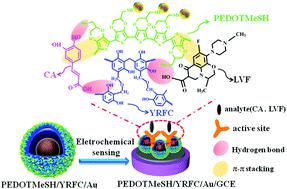当前位置:
X-MOL 学术
›
J. Mater. Chem. C
›
论文详情
Our official English website, www.x-mol.net, welcomes your feedback! (Note: you will need to create a separate account there.)
Preparation of thiol-grafted poly(3,4-ethylenedioxythiophene)/yolk–shell carbon sphere/Au composites for the simultaneous detection of caffeic acid and levofloxacin
Journal of Materials Chemistry C ( IF 6.4 ) Pub Date : 2021-08-31 , DOI: 10.1039/d1tc02194j Nurbiye Sawut 1 , Ruxangul Jamal 2 , Tursun Abdiryim 1 , Aygul kadir 2 , Ruanye Zhang 1 , Zulpikar Helil 1 , Mariyam Niyaz 1
Journal of Materials Chemistry C ( IF 6.4 ) Pub Date : 2021-08-31 , DOI: 10.1039/d1tc02194j Nurbiye Sawut 1 , Ruxangul Jamal 2 , Tursun Abdiryim 1 , Aygul kadir 2 , Ruanye Zhang 1 , Zulpikar Helil 1 , Mariyam Niyaz 1
Affiliation

|
As the void space can increase the effective surface area and the mesoporous shell ensures the fast transmission of electrons and ions, the yolk–shell-structured carbon spheres (YRFC) have been explored as electrode modification materials. Various hybrid nanocomposites of YRFC were studied for expanding their applications. In this work, a thiol-grafted poly(3,4-ethylenedioxythiophene)/resorcinol-formaldehyde yolk–shell carbon nanosphere/Au composite (PEDOTMeSH/YRFC/Au) was fabricated and used as the electrode material for the simultaneous electrochemical detection of caffeic acid (CA) and levofloxacin (LVF). The structure and morphology of the composite were investigated by UV-Vis and FTIR spectroscopy, XRD, XPS, SEM, TEM, EDS, and elemental mapping. The electrochemical performance of PEDOTMeSH/YRFC/Au was evaluated using cyclic voltammetry (CV) and differential pulse voltammetry (DPV), and the results were compared with those of YRFC/Au and PEDOT/YRFC/Au composites. The structural analysis revealed that PEDOTMeSH/YRFC/Au had a higher conjugation degree than the other composites. The morphological analysis indicated that the surface of YRFC was uniformly coated by PEDOTMeSH with well-dispersed Au NPs. The results of electrochemical studies showed that the limits of detection of the PEDOTMeSH/YRFC/Au composite electrodes were 0.014 μM and 0.018 μM, respectively, and the linear detection range was 0.02–320 μM for both CA and LVF.
中文翻译:

硫醇接枝聚(3,4-亚乙基二氧噻吩)/蛋黄-壳碳球/Au复合材料的制备,用于同时检测咖啡酸和左氧氟沙星
由于空隙空间可以增加有效表面积,介孔壳确保电子和离子的快速传输,蛋黄壳结构碳球(YRFC)已被探索作为电极改性材料。研究了 YRFC 的各种混合纳米复合材料以扩展其应用。在这项工作中,制备了硫醇接枝的聚(3,4-亚乙基二氧噻吩)/间苯二酚-甲醛蛋黄壳碳纳米球/金复合材料(PEDOTMeSH/YRFC/Au),并将其用作同时电化学检测咖啡因的电极材料。酸(CA)和左氧氟沙星(LVF)。通过UV-Vis和FTIR光谱、XRD、XPS、SEM、TEM、EDS和元素映射研究了复合材料的结构和形貌。使用循环伏安法 (CV) 和差分脉冲伏安法 (DPV) 评估 PEDOTMeSH/YRFC/Au 的电化学性能,并将结果与 YRFC/Au 和 PEDOT/YRFC/Au 复合材料的结果进行比较。结构分析表明,PEDOTMeSH/YRFC/Au 的共轭度高于其他复合材料。形态学分析表明,YRFC 的表面被 PEDOTMeSH 均匀地包覆,且 Au NPs 分散良好。电化学研究结果表明,PEDOTMeSH/YRFC/Au复合电极的检测限分别为0.014 μM和0.018 μM,CA和LVF的线性检测范围为0.02-320 μM。结构分析表明,PEDOTMeSH/YRFC/Au 的共轭度高于其他复合材料。形态学分析表明,YRFC 的表面被 PEDOTMeSH 均匀地包覆,且 Au NPs 分散良好。电化学研究结果表明,PEDOTMeSH/YRFC/Au复合电极的检测限分别为0.014 μM和0.018 μM,CA和LVF的线性检测范围为0.02-320 μM。结构分析表明,PEDOTMeSH/YRFC/Au 的共轭度高于其他复合材料。形态学分析表明,YRFC 的表面被 PEDOTMeSH 均匀地包覆,且 Au NPs 分散良好。电化学研究结果表明,PEDOTMeSH/YRFC/Au复合电极的检测限分别为0.014 μM和0.018 μM,CA和LVF的线性检测范围为0.02-320 μM。
更新日期:2021-09-17
中文翻译:

硫醇接枝聚(3,4-亚乙基二氧噻吩)/蛋黄-壳碳球/Au复合材料的制备,用于同时检测咖啡酸和左氧氟沙星
由于空隙空间可以增加有效表面积,介孔壳确保电子和离子的快速传输,蛋黄壳结构碳球(YRFC)已被探索作为电极改性材料。研究了 YRFC 的各种混合纳米复合材料以扩展其应用。在这项工作中,制备了硫醇接枝的聚(3,4-亚乙基二氧噻吩)/间苯二酚-甲醛蛋黄壳碳纳米球/金复合材料(PEDOTMeSH/YRFC/Au),并将其用作同时电化学检测咖啡因的电极材料。酸(CA)和左氧氟沙星(LVF)。通过UV-Vis和FTIR光谱、XRD、XPS、SEM、TEM、EDS和元素映射研究了复合材料的结构和形貌。使用循环伏安法 (CV) 和差分脉冲伏安法 (DPV) 评估 PEDOTMeSH/YRFC/Au 的电化学性能,并将结果与 YRFC/Au 和 PEDOT/YRFC/Au 复合材料的结果进行比较。结构分析表明,PEDOTMeSH/YRFC/Au 的共轭度高于其他复合材料。形态学分析表明,YRFC 的表面被 PEDOTMeSH 均匀地包覆,且 Au NPs 分散良好。电化学研究结果表明,PEDOTMeSH/YRFC/Au复合电极的检测限分别为0.014 μM和0.018 μM,CA和LVF的线性检测范围为0.02-320 μM。结构分析表明,PEDOTMeSH/YRFC/Au 的共轭度高于其他复合材料。形态学分析表明,YRFC 的表面被 PEDOTMeSH 均匀地包覆,且 Au NPs 分散良好。电化学研究结果表明,PEDOTMeSH/YRFC/Au复合电极的检测限分别为0.014 μM和0.018 μM,CA和LVF的线性检测范围为0.02-320 μM。结构分析表明,PEDOTMeSH/YRFC/Au 的共轭度高于其他复合材料。形态学分析表明,YRFC 的表面被 PEDOTMeSH 均匀地包覆,且 Au NPs 分散良好。电化学研究结果表明,PEDOTMeSH/YRFC/Au复合电极的检测限分别为0.014 μM和0.018 μM,CA和LVF的线性检测范围为0.02-320 μM。


























 京公网安备 11010802027423号
京公网安备 11010802027423号